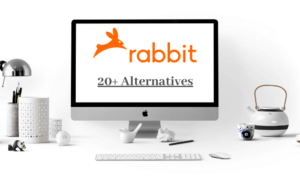Software as a Service has, over the last twenty years, grown exponentially. In 2019, global SaaS revenue exceeded $100 billion, hitting that mark sooner than analysts expected.
Two of the biggest players in the SaaS world are Microsoft (18% market share) and Salesforce (12%), with Adobe, Oracle, and SAP taking large enough slices of the pie to be noticeable, according to SRGResearch. Beyond the market leaders, there are over 10,000 private SaaS companies, including those with angel and VC backing.
Marketing is awash with SaaS companies, with Chiefmartec research identifying that there are at least 6,823 in this space, as of 2018. That figure includes marketing agencies who’ve invested in developing some kind of automated SaaS solution. In this article, we look at understanding the most successful business model for SaaS startups, and SaaS industry trends (2020) to consider.
How popular is SaaS?
In 2014, the overall size of the SaaS market was worth $63.19 billion. Businesses were still hesitant to move to anything cloud-based. Smaller companies and startups could adopt SaaS and other cloud-based solutions more easily; whereas larger ones were still overcoming legacy IT, security, and operational concerns.
Now in 2020, market projections are for global SaaS revenue to reach $157 billion, according to Statista. As another indicator of popularity, up to 80% of companies are using at least one SaaS product. Many are using dozens. Often, due to the relatively low cost of many, employees themselves are recommending new apps and platforms.
In large companies, the average amount spent on SaaS is $343,000 (as of 2018, according to Blissfully). Naturally, smaller companies don’t spend as much, but proportionally to revenues and other costs, there is a clear and irreversible shift to SaaS. Analysts expect this to continue. With the cost of starting a SaaS company reducing, there will be a continuous pipeline of new innovations entering the market in the years ahead.
Why is SaaS so popular?
As we can see, in companies of every size, SaaS is popular. Since the early 2000s, SaaS solutions have been replacing legacy IT systems, hardware, and software. For companies formed more recently, many have only known SaaS, and the relatively low cost of cloud-based software has made it easier for businesses to get the tools they need to start up, grow, and thrive.
There are SaaS solutions for every operational need, from accountancy to sales, productivity to project management, and so much more. For SaaS customers, whether these are individuals or corporations, the cost and time it takes to sign-up and start using a SaaS product is a fraction of legacy software.
Speed, convenience, cloud-powered capabilities, and lower costs are several of the benefits of SaaS. Alongside those, companies using SaaS products and related services don’t need to worry about the hardware, security, or maintenance of these applications. Providers, not customers, are responsible for those costs, thereby making SaaS far more convenient than legacy software.
Will SaaS continue to grow?
Whether you already have a business and want to monetize an element through the development of a software subscription, or you are an entrepreneur wanting to start a SaaS business, don’t think you can’t do this because you aren’t established already. SaaS companies are still being launched. The market is still expanding and growing.
Even with new economic and global uncertainties, as a result of the Coronavirus, consumers and businesses still need software to solve problems. Anything that can be solved with SaaS today, will solve tomorrow’s problems too, which means there is still a market for innovation and new ideas.
How to build a successful SaaS company in 2020?
It used to be the case that to get SaaS companies off the ground, only millions worth of angel and VC investment would be needed. But over the years, the barriers to entry and the cost of launching companies have reduced.
How and where to raise investment is one concern. However, to offset that concern, many founders in recent years have bootstrapped themselves until they’re in a strong position to raise money. So that shouldn’t be the first concern of new founders.
Instead, focus on solving a problem. Founding and launching a successful SaaS company starts with validating an idea. No idea or theory survives contact with reality. So when it comes to building successful SaaS products, the idea must engage with potential customers/users. The easiest and most effective way to achieve that is to develop a Minimum Viable Product (MVP) version. A rough and ready version, far from what the finished one will be, is all a startup needs to test a theory.
In some cases, companies with revenues or funding will work with software development partners to create MVP versions that include analytics and other tools, as a way of providing more detailed insights that propel the business forward.
Once an idea is validated, you need a beta and then a launch-ready version of a SaaS product. Before developing either of those, you need a clear understanding of the total addressable market.
Ask yourself, “how big is this opportunity?” Then look into who your ideal customers are, how to reach them, do they know they need what you are offering.
Sales and marketing are two areas that SaaS companies need to consider early on.
Unless you know the size of the market, and therefore total growth opportunities, raising funding, and becoming profitable is more challenging. It could be you’ve got a great idea, but there isn’t room to grow, or the market is too hard to reach. So, make sure to test, validate, keep testing, and then plan an achievable go-to-market. Get to know your customers and prospects really well.
In the early days of any go-to-market plan for a SaaS company, you should focus on winning a sustainable number of customers. Not too many. Enough to either achieve profitability, if you’re bootstrapping or enough to demonstrate potential revenue metrics for investors. One of the most crucial things SaaS startups need is to over-deliver for new customers, especially in the first year.
SaaS business model – keys to success
One of the SaaS business model’s keys to success is to provide first-class service and customer support. You want to ensure those first 10 to 100 customers (depending on whether your market is small businesses or big corporates) are delighted with the service and product. Not only will this make it easier to demonstrate sustainable revenue, but there is enormous value in positive case studies, testimonials, and word-of-mouth marketing (referrals).
Whether or not you take investment, a fundamental aspect of the SaaS business model and key metrics is growth. Making it sustainable, and the only way to achieve that is with a product/service that addresses a large enough market to make the business viable. Testing those initial assumptions is one of the most effective ways to identify customer needs, then drive forward future growth.
Developing a SaaS-based business model in 2020 is one of the best ways to monetize subscription trends. Businesses and customers love SaaS products. Demand is high and will remain so. Once you’ve picked a problem to solve and identified a niche/target market, the smartest move forward is to start validating and testing your theories and assumptions.
Source: https://99firms.com/blog/saas-statistics/





















